Confluence of Cultures
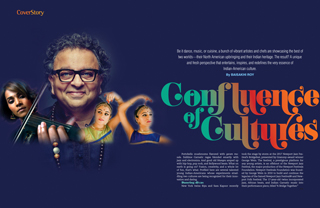
Be it dance, music, or cuisine, a bunch of vibrant artistes and chefs are showcasing the best of two worlds—their North American upbringing and their Indian heritage. The result? A unique and fresh perspective that entertains, inspires, and redefines the very essence of Indian-American culture.
Portobello mushrooms flavored with garam masala. Sublime Carnatic ragas blended smartly with jazz and electronica. And good old bhangra amped up with hip-hop, pop rock, and Bollywood beats. What on earth is going on? Fusion, creativity, and a whole lot of fun, that’s what. Profiled here are several talented young Indian-Americans whose experiments straddling two cultures are being recognized for their innovation and daring.
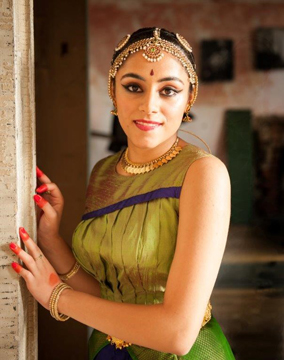
Sara Kapoor
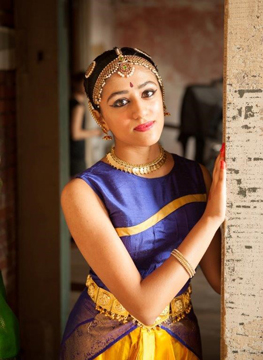
Riya Kapoor
Dancing divas
New York twins Riya and Sara Kapoor recently took the stage by storm at the 2017 Newport Jazz Festival’s Bridgefest, presented by Grammy-award winner George Wein. The festival, a prestigious platform for any young artiste, is an offshoot of the Newport Jazz Festival, the major production of the Newport Festivals Foundation. Newport Festivals Foundation was founded by George Wein in 2010 to build and continue the legacies of the famed Newport Jazz Festival® and Newport Folk Festival. The 17-year-old twins incorporated jazz, African beats, and Indian Carnatic music into their performance piece, titled “A Bridge Together.”
“We were both pleasantly surprised that all our genres being so starkly different, the 14-odd musicians blended together effortlessly. All the percussion instruments, especially the West African music, worked so well together plus so many of the rhythms were similar which made it such an amazing collaborative experience,” says Riya, who is also a student at the esteemed Alvin Ailey School of Dance. Both sisters trained in traditional South Indian dance at age 4 ½ with danseuse guru Swati Bhise, a protégé of renowned Indian classical dancer Sonal Mansingh, receiving intensive instruction in Bharatanatyam—a dance form over 2,000 years old that requires mastery of dance, music and rhythm, theater and mime, and iconography. From planning the challenging choreography to having to translate for their diverse band of musicians and balancing all of the above with their college assignments, the performance was clearly a passion project for the duo.
“These young women are tremendous,” said Mr. Wein, who has worked with such musical luminaries as Ella Fitzgerald, Duke Ellington, and Charlie Parker. “The dances are very intricate and beautiful, but what I loved is how they brought jazz into these very traditional art forms. They’ve modernized the dances in a wonderful way while adding a delightfully different perspective to jazz music,” he said of their path-breaking Newport performance.
The sisters, who grew up listening to an eclectic body of music, are keen to create pieces that are reflective of their dual culture. “Our intention is to pay tribute to both cultures and to also highlight the fact that music and any art forms are unifying in nature. The fact that different sounds and beats can come together coherently to become something so effortlessly beautiful is eye-opening,” says Sara. And they pay no heed to naysayers who raise their eyebrows at the attempt to experiment with a classical art form. The sisters have loftier goals.
“Fusion is interesting, exciting, and powerful. In these times when ongoing and intense cultural battles have our world in turmoil, it’s the arts that rise above everything else and bring people together. And we want to do just that,” signs off Riya.
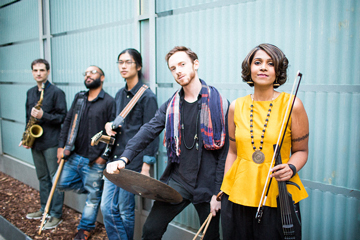
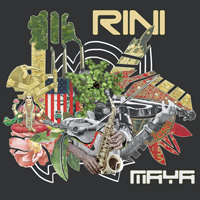
The album Maya, from Harini Raghavan and her band Rini, is a funky blend of Carnatic music and electronica.
Carnatic goes funky
Harini Raghavan felt spiritually connected to Carnatic music, having been trained in it from a very young age, thanks to her grandmother’s urging. But she also felt the irresistible pull of jazz harmonies. The Chennai-born and New York-based violinist, vocalist, and composer’s sounds are undoubtedly inspired by both. “I am inspired by music that blends elements of different cultures in different ways––sonically, rhythmically, harmonically, and vocally. I am inspired by the diversity in New York City, being able to live in a global city and find my place, share my culture via music. A lot of my music is also inspired by sci-fi shows and anime that deal with space exploration, time travel, and a future for humanity beyond our world,” she says. Raghavan and her band Rini released Maya, a funky blend of
Carnatic music and electronica, in 2017.
Inspired by a talk by writer Amitav Ghosh, Maya reflects on the delusion that all is well and the starkly contrasting reality of the threat of climate change, painting two sonic pictures with a tip of the hat to music group Beats Antique. “The Red Moon,” a modal piece based on a classical raga, incorporates mantras chanted during solar eclipses, asking listeners to reflect on our susceptibility to misreading cosmic phenomena in limited human terms. She also paid tribute to her hometown, capturing the pleasures of a strong cup of coffee during the classical music season in “Filter Kapi,” a tribute to Chennai’s favorite drink.
She harks back to 2015 where the band came together and found a way to synergize their musical influences to come up with sound that was funky and groovy. “I wanted to write and produce music that was unique, create a musical structure based on my influences with space for a multicultural band that brought its own influences. Using my Electronic Production skills from Berklee, I started using synths that have a world of different timbres and help me weave together melodies, rhythms, and sounds of the East and West. The bassist Achal Murthy is from Luxembourg. He plays metal, rock, jazz, and some Bollywood now as well. The guitarist Aleif Hamdan is from Indonesia and he plays jazz, blues, rock, and some Indo jazz. The drummer Maxime Cholley is from France. He plays jazz, musical theatre, rock, and Middle Eastern fusion music. The sax/EWI player Íñigo Galdeano Lasheras is from the Basque Country. He plays a lot of jazz and some Brazilian music as well,” she says.
Raghavan names European and UK bands and artists like Imogen Heap, Sigur Ros, Ludovico Einaudi, Steven Wilson, and Radiohead as her influences. Keeping in sync with her roots, an obvious favorite is A. R. Rahman and popular Tamil film composer Ilaiyaraaja. “Ilaiyaraaja, in the way he blends Indian classical ragas with Western classical harmonies and arrangements, and A. R. Rahman for experimenting with synths are both so inspiring,” she says.
Raghavan, who uses Carnatic ragas as a basis for melodies and backs it up with a mix of modal harmonies and jazz harmonies in a way that is aesthetically pleasing and interesting, is also known to add unison lines that have rhythmic influences from Carnatic konnakols (vocal syllables), and interesting harmonies that have a nontraditional movement and open up spots for improvisation from the band so it brings in their influences and adds more color to the composition. “To me, fusion music is a broad name given to a variety of unique blends of different styles. It is a world of possibilities where each artist or band can create their own signature sound based on how they blend the styles,” she says.
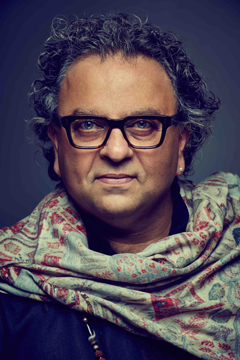
Vikram Vij’s restaurants are famous and his prepackaged gourmet curries are widely popular.
Palate pleaser
He owns some of the finest Indian restaurants in Canada and, according to some, in North America, even. A cookbook author and a dragon (from the Canadian reality TV show Dragons’ Den, that is), Vikram Vij was famously quoted in the Globe and Mail, one of Canada’s leading newspapers, about some of his pet peeves when it came to actually eating Indian fare. “Do we make love with knives and forks? Then why while eating? Use your hands!” he said. Perpetually passionate about Indian cuisine, be it taste, presentation, or the ingredients used, Vij has made it his mission to make Indian cuisine desirable to even those not familiar with the culture and the richness of its palate—thus, his passion for and mastery in fusion cuisine. “Indian food is not very easy to present. Everything is in shades of brown but the taste is so diverse! The key is in making it look pleasing to the eye! And it is important to realize that we eat food through all our senses...the texture, the aroma, and obviously the taste…,” he says.
After growing up in Amritsar and Delhi, Vij trained in French cuisine in Austria and became a chef and later, a certified sommelier. Moving to Canada in 1989, he collaborated with his then wife and now business partner, Meeru Dhalwala, to open Vij’s Restaurant in 1994. His line of prepackaged gourmet curries are all the rage. The master chef takes pride in putting out his soul on a plate. Cooking, he says, is so much fun, and “I’ve never cut corners when preparing a dish. At our restaurants, we roast all our spices and chop fresh garlic, ginger, and onions—I’ve never used pastes as substitutes! Also we make individual sauces for each dish so they look and taste different.”
Vij is well aware that today’s food connoisseur is a well-travelled global citizen, knowledgeable about her food and drink. “People now are travelling the world and are more adventurous about food. They have access to information that tells them what chefs are known for what kind of specialized cuisine, and they expect their taste buds to be pampered,” he notes. Some of his signature dishes are reflective of his fondness for tweaking the traditional Indian dish to suit a more global landscape. He cooks his goat meat with cassava instead of the usual potatoes. “It lends it more meatiness and texture. I cook it really slowly,” he shares.
Then, there’s the portobello mushroom—what does one do with it in an Indian kitchen? “We cook it using garam masala and make a sumptuous porcini cream curry,” he says. Vij is also serving up some exciting fusion snacks. His kettle chips flavored with garam masala, served with an achari dip, washed down with his own brew, ‘Vikram’s Weissen’ (a German and Belgian blend, with a “right smack in the middle” taste according to Vij) is his latest contribution to the culinary scene.
But his go-to ingredient? Namaste...a sense of hospitality and a way to honor what we are eating. “It matters as much as the food you are serving,” he declares.
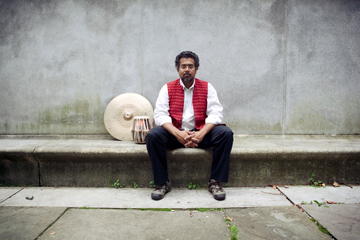
Sameer Gupta switches easily between Indian classical music on the tabla and American jazz on the drum set.
Rocking ragas
Sameer Gupta explored several musical disciplines ranging from Western classical to jazz to Indian classical music. No wonder that the three elements are featured in his new record, A Circle Has No Beginning, which came out in February this year. “I wanted to do justice to this sonic palette; the density and layers of jazz, piano, drums, a core rhythm section, with the cello and violin,” says Gupta, who is known as one of the few percussionists simultaneously representing the traditions of American jazz on drum set, and Indian classical music on tabla. The New York-based percussionist and composer is also a cofounder and an Artistic Director of the Brooklyn Raga Massive—a nonprofit that endeavors to give a platform to artists and music lovers who are keen to explore the richness of the Indian classical music scene in the New York area. “I find that some Indian classical musicians don’t know as much about American jazz in depth. Movements such as The Massive are also a way to preserve that cultural heritage while bringing awareness to its richness and variety,” he says.
Gupta’s album reflects the influence of his dual Indian and American heritage. Tracks like “Come Take Everything” and “With Blessings” are a nod to classic Bollywood numbers from the ’60s. “Some of my favorites from the golden era of Bollywood are songs by Manna Dey and Kishore Kumar. The number “Lo har cheez lelo” … the music of the old film Ab Dilli Door Nahin ... [music like that] still resonates with me,” he says. He also lends a creative twist to a melody by 18th century Carnatic composer Tyagaraja as an improvisational springboard for the ensemble, and matches the Native American tune known as the American Indian Movement Song with a late-night Carnatic raga (“Two Faces of the Moon”). Several of his other pieces on the album are inspired from his living in New York, like “Innocence in Harlem.”
Gupta fondly recalls his first formative musical year in his youth, spent in the basement with his older brother jamming on a guitar, and also listening to copious amounts of rock and jazz, especially John Coltrane. “Coltrane’s sound was a profound revelation for me at that age, when I was about 16 years old. I grew curious about the energy of improvisational music. I wanted to work with that unpredictability and potential chaos and see where it could take me creatively. I was lucky to have good teachers who taught me to appreciate the cultures that these sounds are steeped in,” he says.
He says it’s difficult to talk about music, but it’s important to listen and dig deep and to understand the source of the sounds of this music. “Let’s take jazz; it has actually informed my philosophy about life. We, as listeners, need to understand the social context of the early Indian and jazz crossover music, like Don Cherry or John Handy, Charles Mingus and Miles Davis as well. To try and learn from what their struggle was, what their history was. It can be very uplifting because many of us relate to the social struggle,” he says.
“Music ultimately has to be moving. Whether a listener knows the craft or not, the final impression has to be moving and genuine; it has to elevate the senses, while trying to respectfully push the boundaries of what our creative minds are capable of realizing,” he concludes.
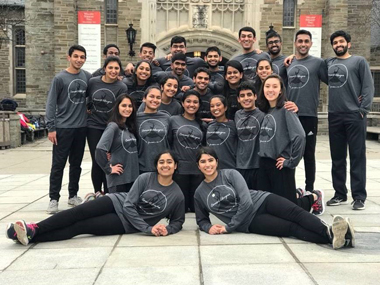
The two-decade-old Cornell Bhangra is the longest-running collegiate bhangra group in North America.
Star performers
The joy and abandon that the dancers of Cornell Bhangra bring into all their performances is infectious. But then they are performing one of the most exuberant Indian folk dances of them all—the bhangra. In its 20th year, Cornell Bhangra is the longest-running collegiate bhangra group in North America. They took the world by storm when they managed to make it to the quarterfinals of NBC’s hit show America’s Got Talent in 2014. They also won the Bhangra Crew competitions in 2013 and 2014 and Bhangra Blowout in 2015—legit international competitions where dance crews from all over the world compete for glory.
“We love bhangra, especially the team aspect of it…when rehearsing, we make such memorable experiences with our fellow dancers. It’s like a team sport—we are bonded for life,” asserts Sonali Razdan, president and co-captain of Cornell Bhangra at Cornell University.
Founded in 1997, Cornell Bhangra began with the sole purpose of promoting awareness of Punjabi dance and culture in the community at Cornell and across the United States. The ever popular bhangra is a folk dance originating in the state of Punjab in northern India and Pakistan that celebrates the arrival of spring and everyday life in Punjab. Thanks to Bollywood and the prolific rise of Punjabi music superstars like Jazzy B, Malkit Singh, Yo Yo Honey Singh, Badshah, and many others, Punjabi music and, by extension, bhangra is a fixture at clubs and Indian weddings alike.
Every year, Cornell hosts Pao Bhangra, the largest student-run show on the Cornell campus as well as the largest bhangra exhibition in all of the United States. This year the mega event was hosted at their campus on March 24th.
Cornell Bhangra’s wildly popular performances and clips on YouTube, with a heavy dose of hip hop, jazz, and pop rock (not to mention popular Punjabi pop numbers from Bollywood films) are all blended with traditional bhangra beats—diverse sounds that appeal to the current generation and to the non-South Asian audience. This fusion is reflected in the choreography, too, which has elements of breakdancing and hip hop, coupled with elements taken from other Indian traditional dance forms.
“Only two of our crew of 30 are Punjabi. There is so much curiosity about Punjabi culture, the music and dance forms, and it’s understandable. There is a joie de vivre in bhangra which appeals to people of all backgrounds and of all ages. When we hold auditions on campus inviting people to join, we are flooded with students who want to be part of our crew,” she says.
“East is East, and West is West, and never the twain shall meet,” said Rudyard Kipling famously. Not anymore. Looking at the heady blend of can-do and novelty that infuses these restless young artistes, and the enthusiastic reception they are generating, Mr. Kipling might well have had to concede that he was wrong, were he still around!
Baisakhi Roy is a Toronto-based writer and online editor who loves to write about ordinary people and their extraordinary stories. She also loves doing Legos with her 9-year-old daughter.
Enjoyed reading Khabar magazine? Subscribe to Khabar and get a full digital copy of this Indian-American community magazine.
blog comments powered by Disqus










